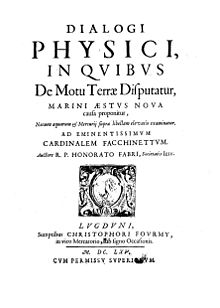Honoré Fabri
Honoré Fabri | |
|---|---|
 | |
| Born | April 5, 1607 |
| Died | March 8, 1688 (aged 79) |
| Nationality | French |
| Occupation(s) | Mathematician, physicist, Jesuit theologian, controversialist |
| Part of a series on the |
| Society of Jesus |
|---|
 |
| History |
| Hierarchy |
| Spirituality |
| Works |
| Notable Jesuits |
|
|
Honoré Fabri (Honoratus Fabrius; 5 April 1607 or 8 April 1608[1] – 8 March 1688) was a French Jesuit theologian, also known as Coningius. He was a mathematician, physicist and controversialist.[2][3]
Biography
[edit]Honoré Fabri was born on 5 April 1607 in Virieu-le-Grand, Ain, France. He entered the Society of Jesus at Avignon in 1626. He taught philosophy for eight years and mathematics for six years at the Jesuit college at Lyons, attracting many pupils. Called to Rome, he became the theologian of the court of the papal penitentiary in the Vatican basilica, a position he held for thirty years.[2][3]
Fabri was a highly respected scientist among his contemporaries. He was elected to the Accademia del Cimento in 1657, the year the academy was founded.[2] Leibniz placed him with Galileo, Torricelli, Steno and Borelli for his work on elasticity and the theory of vibrations, and alone with Galileo for his efforts to 'rationalise experimental kinematics'. Mersenne rated him 'a veritable giant in science'[4]
He died on 8 March 1688, at the age of 79 in Rome.
Works
[edit]
Sommervogel mentions thirty-one titles of published works in connection with Fabri's name, alongside fourteen of his productions in manuscript, in the Library of Lyons.
The following are the more important of his publications:
- Tractatus physicus du motu locali (1646).
- Metaphysica Demonstrativa, Sive Scientia Rationum Universalium (Lyon, 1648).
- Pithanophilus, seu dialogus vel opusculum de opinione probabili, etc. (Rome, 1659).
This work was attacked by Stefano Gradi, Prefect of the Vatican Library, in his Disputatio de opinione probabili (Rome, 1678; Mechlin, 1679).
- Honorati Fabri, Societatis Jesu, apolgeticus doctrinæ moralis ejusdem Societatis, (Lyons, 1670; Cologne, 1672).
This treats, in eleven dialogues, of probabilism, explaining its true nature, and refuting the charges of its opponents. The Cologne edition was considerably enlarged but did not meet with ecclesiastical approbation; it was placed on the Index of forbidden books soon after its appearance.
- Una fides unius Ecclesiæ Romanæ contra indifferentes hujus sæculi tribus librus facili methodo asserto, (Dillingen, 1657).
- Summula theologica in quâ quæstiones omnes alicujus momenti, quæ a Scholasticus agitari solent, breviter discutiuntur ac definiuntur, (Lyons, 1669).
The principles on which this work constructs its theological conclusions are far different from those of Aristotle.
- Euphiander seu vir ingeniosus, (Lyons, 1669; Vienna, 1731; Budapest, 1749; Ofen, 1763).
Most of Fabri's other works deal with philosophy, mathematics, physics, astronomy, and even zoology. In his treatise on man, he claims to have discovered the circulation of the blood, prior to William Harvey, but after having investigated this question, Auguste Bellynck arrives at the conclusion that, at best, Fabri may have made the discovery independently of Harvey.[2][5]
- Dialogi physici sex quorum primum est de Lumine (1669) ["Six dialogues on physics: the first is on Light"] is a treatise on physics in dialog form. The first dialog contained description of Grimaldi's experiments reported in Physico-mathesis de lumine (1665), which included the first reports of diffraction.[6] Isaac Newton by his own admission[7] learned about diffraction from the first dialog. The book was sent to Newton by John Collins on 30 April 1672.[8]
See also
[edit]References
[edit]- ^ "Fabri, Honoré". Scholasticon (in French). Archived from the original on 23 January 2023. Retrieved 23 January 2023.
5.IV.1607, ou 8.IV.1608 selon d'autres source
- ^ a b c d Honoré Fabri. www-history.mcs.st-andrews.ac.uk
- ^ a b Elazar, Michael (2011). Honoré Fabri and the Concept of Impetus: A Bridge between Conceptual Frameworks: A Bridge Between Conceptual Frameworks. Springer. pp. 5–. ISBN 978-94-007-1605-6.
- ^ John L. Heilbron, Electricity in the 17th and 18th centuries: A study of early modern physics. Univ of California Press, 1979. p. 195.
- ^ cf. Bellynck (1864) Cours de Zoologie, p. 23.
- ^ "Francesco Grimaldi - Biography". Maths History. Retrieved 30 March 2023.
- ^ Newton, Isaac (1959). Turnball, H. W. (ed.). The Correspondence of Isaac Newton: Volume 1: 1661–1675. Vol. 1. Cambridge: Cambridge University Press. pp. 383–384. ISBN 978-0-521-73783-8.
- ^ "Beyond the Fringe: Diffraction as seen by Grimaldi, Fabri, Hooke and Newton". Notes and Records of the Royal Society of London. 44 (1): 13–23. 31 January 1990. doi:10.1098/rsnr.1990.0002. ISSN 0035-9149.
Further reading
[edit]- Sommervogel, Bibliothèque de la Compagnie de Jésus (Brussels and Paris, 1892), III, 511–521;
- Hugo von Hurter, Nomenclator Literarius (Innsbruck 1893), tom. II, 598–600.
- Palmerino, Carla Rita, "Fabri, Honoré (c. 1608–1688)", in : Dictionary of Seventeenth Century French Philosophers, ed. Luc Foisneau, London – New York : Thoemmes – Continuum, 2008, vol. I, 453–460
External links
[edit]- Elazar, Michael; Feldhay, Rivka (2018). "Jesuit Conceptions of Impetus After Galileo: Honoré Fabri, Paolo Casati, and Francesco Eschinardi". Emergence and Expansion of Pre-Classical Mechanics (pp.285-323). doi:10.1007/978-3-319-90345-3_10.
- Honoré Fabri, S.J. (1607 to 1688) and his post-calculus geometry Archived 24 February 2013 at the Wayback Machine
- O'Connor, John J.; Robertson, Edmund F. (September 2022), "Honoré Fabri", MacTutor History of Mathematics Archive, University of St Andrews
- Galileo Project page
- Honoré's (1667) Synopsis optica - digital facsimile from the Linda Hall Library
![]() This article incorporates text from a publication now in the public domain: Herbermann, Charles, ed. (1913). "Honoré Fabri". Catholic Encyclopedia. New York: Robert Appleton Company.
This article incorporates text from a publication now in the public domain: Herbermann, Charles, ed. (1913). "Honoré Fabri". Catholic Encyclopedia. New York: Robert Appleton Company.
